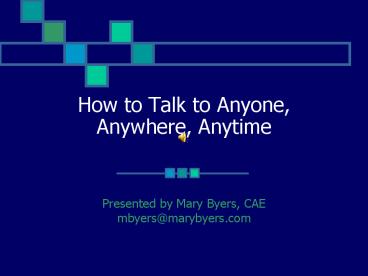How to Talk to Anyone, Anywhere, Anytime - PowerPoint PPT Presentation
1 / 36
Title:
How to Talk to Anyone, Anywhere, Anytime
Description:
Smile. Practical ways to be other-centered: Make eye ... Smile. Use notes instead of a word for word manuscript. Get out from behind the podium and MOVE! ... – PowerPoint PPT presentation
Number of Views:580
Avg rating:3.0/5.0
Title: How to Talk to Anyone, Anywhere, Anytime
1
How to Talk to Anyone, Anywhere, Anytime
- Presented by Mary Byers, CAE
- mbyers_at_marybyers.com
2
Communicating Successfully Requires
- Being other-centered rather than self-centered.
3
Being other-centered rather than self-centered.
- Worry more about your audience and less about
yourself.
4
Being other-centered rather than self-centered.
- Worry more about your audience and less about
yourself. - Dont let them see you sweat.
5
Being other-centered rather than self-centered.
- Worry more about your audience and less about
yourself. - Dont let them see you sweat.
- Fake it til you make it. (Act like the speaker
you want to be. Great speakers)
6
Communicating Successfully Requires
- Being other-centered rather than self-centered.
- Asking what is it that they need to know and
why?
7
Communicating Successfully Requires
- Being other-centered rather than self-centered.
- Asking what is it that they need to know and
why? - Preparation every 20 minutes of presentation
time requires an hour of preparation time
8
Practical ways to be other-centered
- Make eye contact
9
Practical ways to be other-centered
- Make eye contact
- Smile
10
Practical ways to be other-centered
- Make eye contact
- Smile
- Use notes instead of a word for word manuscript
11
Practical ways to be other-centered
- Make eye contact
- Smile
- Use notes instead of a word for word manuscript
- Get out from behind the podium and MOVE!
12
Practical ways to be other-centered
- Make eye contact
- Smile
- Use notes instead of a word for word manuscript
- Get out from behind the podium and MOVE!
- Make it interactive
13
Asking what is it that they need to know and
why?
- The answer to this question will form the
foundation of your presentation. - Use mind-mapping.
- Also ask how can I make this interesting? (Use
stories!)
14
Mind-Mapping
15
Stories
- Get an audience listening
16
Stories
- Get an audience listening
- Provide change of pace
17
Stories
- Get an audience listening
- Provide change of pace
- Can be entertaining
18
Stories
- Get an audience listening
- Provide change of pace
- Can be entertaining
- Teach without preaching
19
Stories
- Get an audience listening
- Provide change of pace
- Can be entertaining
- Teach without preaching
- Enhance memorability
20
Stories
- Get an audience listening
- Provide change of pace
- Can be entertaining
- Teach without preaching
- Enhance memorability
- Make it personal for audience
21
Preparation
- Keep a file of interesting facts and statistics.
- Jot down story ideas and keep them for future
reference. - Practice in front of a mirror and in your mind.
22
Great speakers think less about what they have to
say and more about what they have to ask.
23
Questions to ask yourself
- What do I need to know about my audience?
- What can I say that will be of interest to my
audience? - What stories can I include?
- What shouldnt I cover?
24
Know your audience.
- Demographics (male, female, age)
- How many?
- Room layout
- AV Requirements (Dont fall prey to death by
Power Point!)
25
When youre able to make the audience think,
laugh, or come to a new understanding, they will
think youre a great speaker.
26
Five Tools to Make You More Successful
- Mind
27
Five Tools to Make You More Successful
- Mind
- Energy
28
Five Tools to Make You More Successful
- Mind
- Energy
- Face
29
Five Tools to Make You More Successful
- Mind
- Energy
- Face
- Body
30
Five Tools to Make You More Successful
- Mind
- Energy
- Face
- Body
- Voice
31
Voice
- Rate
- Pitch
- Volume
32
A Word About Communicating One-on-One
- Utilize the Three Questions technique
33
A Word About Communicating One-on-One
- Utilize the Three Questions technique
- Im interested in learning more. Would you tell
me about that?
34
It only takes a little effort to move from being
mediocre to magnificent.
35
Think you can, or think you cant, and either
way you will be right. --Henry Ford
36
www.ada.org/goto/newdent































